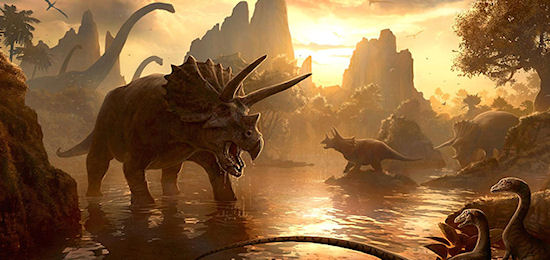Many different species in the history of life on this planet have simply ceased to be. Gone but not forgotten these strange animals leave evidence of their existence entombed in the sedimentary layers of the earth's crust.
As fascinating as these fossilized discoveries are, what's even more fascinating is the mystery of what happened to them.
The dinosaur's story is certainly the most compelling of all the extinction records. Giants that reigned over the earth their disappearance is both perplexing and intriguing.
New theories are formulated as new scientific discoveries are made but even the experts in the field cannot agree on the facts behind the end of the dinosaur era.
Buried deep in the past, the only clues remaining, point to a number of different theories.
Asteroids Or Volcanoes?
Approximately 65.5 million years ago an event occurred that caused the mass extinction of about 70% of the earth's animal and plant species in a relatively short geological time period. It is called the Cretaceous-Tertiary extinction event or the K-T extinction event. A thin band, a geological signature called the K-T boundary, identifies this.
Around the world dinosaur remains (of the non-avian variety) have only been discovered below this K-T boundary. This points to the conclusion that dinosaurs became extinct either right before the event or because of it.
Luis and Walter Alvarez, along with scientists from the University of California during the late seventies were studying closely the K-T boundary in Gubbio, Italy when they made an interesting discovery. In a clay layer at the boundary point they found 30 times the normal level of a rare element called Iridium. Such high levels of Iridium, it has been theorized, could have only come from two sources: either asteroids or violent volcanic activity.
The Asteroid
Many in the scientific community have postulated this impact event theory. The theory suggests that a large asteroid fell to earth and created a cloud of dust and other aerosols that blocked the sun's rays for up to a year. This reduction in sunlight radically affected plant and animal life causing a change to the atmosphere. At the time of impact a pulse of intense radiation killed many species and the resulting climate change and global firestorms decimated the rest.Dinosaurs, because of their size, were the first to succumb.
Volcanic Activity
The Deccan Traps, located in western India, formed at the end of the Cretaceous period, the same time the dinosaurs disappeared from earth. The Traps are a bi-product of violent volcanic eruptions. This theory postulates that the volcanic activity at the time would have released massive amounts of sulfuric aerosols and ash into the atmosphere again causing a major shift in the earth's climate. A shift that the dinosaurs were not equipped to survive.
Ice Age
Another theory relies on the idea of a major drop in temperature that caused the dinosaurs to die out while allowing the warm-blooded, more insulated mammals to survive. In this case all the plant, animal and marine life that could not adapt to the plummeting temperatures became extinct. A number of scientists pair this theory with the asteroid theory, claiming it was the asteroid that triggered the deep freeze.
There are many plausible explanations and scientific theories regarding the extinction of the dinosaurs. New scientific evidence is discovered all the time, which supports one hypothesis or another, however, the truth is that we really don't know what ended the reign of these giants of the prehistoric world.
It is a mystery that may remain until the moment of our extinction.




